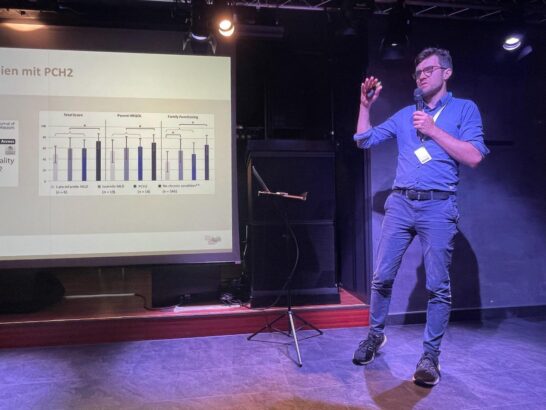Summary
The aim of the study “Natural course of pontocerebellar hypoplasia type 2A” by Sánchez-Albisua et al. was to describe the natural course of PCH2 using a uniform group of patients with the typical PCH2A mutation.
Participants and course of the study
A total of 33 patients from German-speaking countries were included who had both the typical findings in the MRI of the brain and the PCH2A-typical mutation (p.A307S). The data were collected on the basis of doctors’ letters and a questionnaire that was completed in a telephone interview with the parents of the affected children.
Data collected
The questionnaire collected data on age, time and cause of death, if applicable, pregnancy and birth as well as symptoms and development of the children. In addition, data on the care of the children and their physical development (height, weight, head circumference) was obtained from the available medical reports.
Results: Survival, pregnancy, body measurements
At the time of data collection, 9 patients had already died at a median age of 6 years and 7 months. This means that 53% of the children had died by the age of 11 years.
A comparison of children who showed prenatal abnormalities with those who did not, revealed no difference in the severity of the disease after birth.
At birth, the children showed normal measurements in terms of length, height and head circumference, with the latter being in the low normal range. However, with increasing age, the head circumference was too low and thus corresponded to the diagnosis of microcephaly.
Results: Symptoms
- 88% of the children showed choreoathetosis, 12% pure spasticity. This means that 100% of the children had a movement disorder
- 82% of the children had epileptic seizures
- 100% of the children had feeding difficulties
- 96% of the children suffered from sleep disorders
- Apnoea occurred in 67% of cases
- Gastro-oesophageal reflux was diagnosed in 73% of the children
Results: Development
All children made progress, albeit at a low level:
- 76% of the children were able to follow/ fixate with their eyes
- 76% of the children attempted to grasp objects offered to them
- 73% of the children showed moderate head control
- 70% of the children showed a response smile
- 58% of the children turned from prone to supine position
- 9% of the children were able to sit independently
Conclusion
Patients with PCH2A show a severe course of the disease and a reduced survival rate. However, some developmental steps are possible.
The study was the first systematic analysis of a uniform group of affected children with regards to survival, body measurements, symptoms and development thus laying the foundation for further similar studies.
Read the Complete Study
Find the complete study here:


